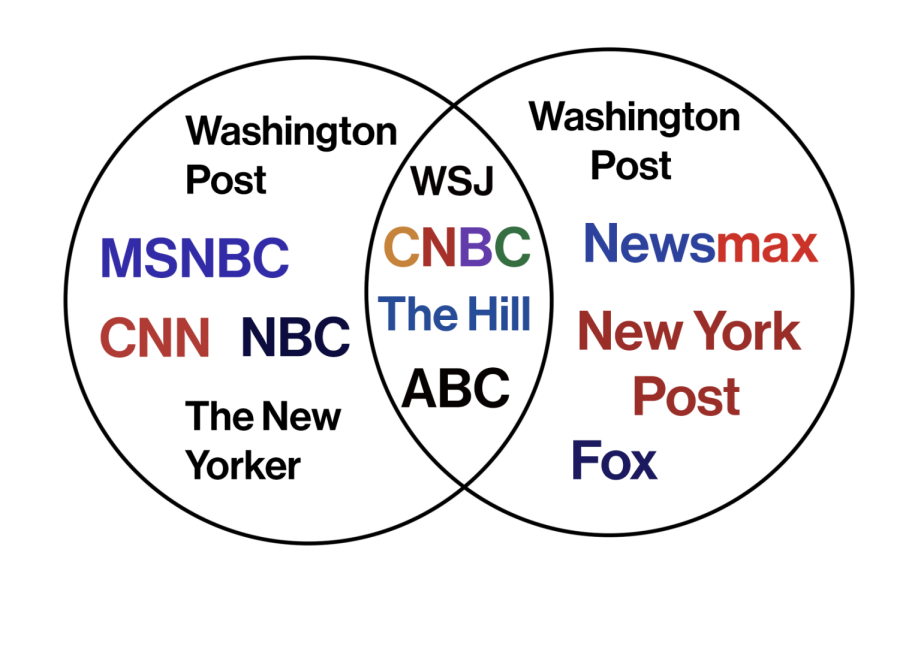Bias report: Who should we trust?
Studies help decipher bias in nationwide news stations
Graphic by Hanna Asmerom shows left-, center-, and right-leaning news sources based on information from the Pew Research Center
November 8, 2022
FOX NEWS: 47% of people with consistently conservative views watch Fox News to receive updates on government and politics
With a distrust rate of 40% among American adults surveyed by Pew Research Center in 2019, Fox News takes the title of the most distrusted news station in America. Known for its right-leaning bias, Fox News originally formed strong links with the Republican party after the Sept. 11 attacks, finally exceeding their rival’s, CNN’s, viewers. Since then, Fox has dominated the news industry with their 2.1 million viewers and continues to promote conservative views.
CNN: 20% of people with majority liberal views watch CNN to receive updates on government and politics
With a distrust rate of 32%, CNN takes second place in most distrusted news sources, according to the Pew Research survey. While once noted as a “center” and neutral news station, CNN has recently switched to a more left-leaning bias. Along with Fox and MSNBC, CNN became more opinionated and frequently left out damaging stories to the liberal side during the 2020 presidential election. However, according to the survey, CNN is not majorly distrusted by conservatives but rather a mix of both left and right, unlike its fellow left-leaning news station, MSNBC.
MSNBC: 12% of people with consistently liberal views watch MSNBC to receive updates on government and politics
Though MSNBC is not the most viewed news source by consistently liberal people, 75% of the conservatives who were surveyed did not trust MSNBC as a reputable source. Owned by NBC, MSNBC openly skews more left than CNN, who tried to be known as “nonpartisan” for years. MSNBC is strongly disliked by most because of their tendency to use opinion over valid sources. According to a Politico article written by Dylan Byers, MSNBC is mainly used as “a counterbalance to Fox.” While CNN is the supposed middleman in this search to find unbiased stations , MSNBC is argued to be as opinionated as Fox News, if not more.
Wall Street Journal: 88% of respondents to an AllSides blind survey claimed WSJ as “center”
The business-focused, daily newspaper is one of the most unbiased sources rated by the public. Though the owners of WSJ also own Fox News, The Times and The Sun, the Wall Street Journal remains independent in its journalistic style and unbiased sources. While most of the population believes all news sources contain bias, television networks and social media are considered more biased than newspapers and local networks. Even though controversies surround the bias of WSJ’s opinion column, the Wall Street Journal is one of the most unbiased and factual sources to receive news in politics and business.
When consuming information both online or on paper, assessing your sources for bias can help make sure the information is not skewed. One way to avoid media bias is by educating yourself on strategies media sources use to persuade their audiences.
One book that helps to decipher political media “The Red and the Blue” by Steve Kornacki. Kornacki is an NBC correspondent who writes a detailed analysis of the world’s current political landscape from the 1990s to now. Another book that can help to decipher political jargon from truth is “Skewed: A Critical Thinker’s Guide to Media Bias.” In the book, author Larry Atkins helps readers separate selective reporting from accurate information. Atkins discusses “advocacy journalism” which describes the way that journalists advocate a biased worldview.
There are also some telltale signs of a biased article, including but not limited to, exaggerated language, one-sided points of view and consistently right- or left-leaning opinions.
Sources for Statistics and News Bias
- All news stations
https://www.pewresearch.org/fact-tank/2020/04/08/five-facts-about-fox-news/
- Fox and CNN
https://deadline.com/2022/08/fox-news-august-ratings-gutfeld-1235103363/
- Fox and CNN
https://www.thefactual.com/blog/is-cnn-biased/
- CNN
https://adfontesmedia.com/msnbc-bias-and-reliability/
- MSNBC
https://www.politico.com/blogs/media/2013/12/is-msnbc-worse-than-fox-news-179175
-MSNBC







